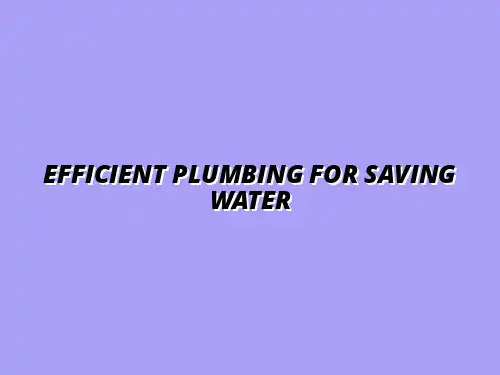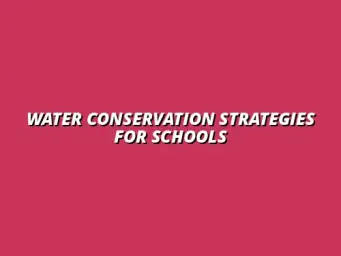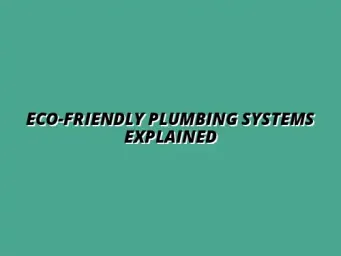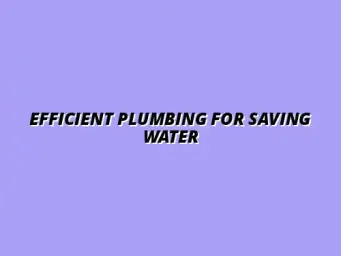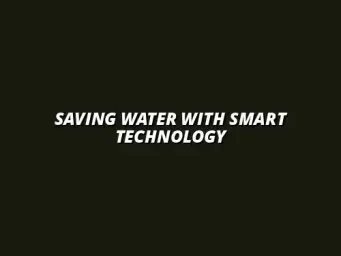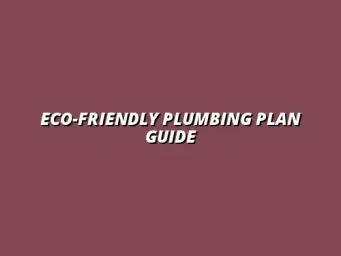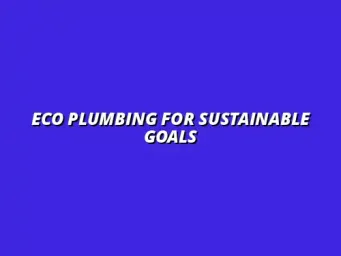Understanding the Importance of Water and Energy Savings in Plumbing
Water and energy are two vital resources that many of us take for granted. However, the choices we make in our plumbing systems can significantly affect the consumption of these precious resources. By understanding the impact of our plumbing choices, we can make informed decisions that lead to savings for our wallets and the planet.
When we think about plumbing, we often focus on functionality and aesthetics. But there’s a deeper layer to consider: the environmental impact. Each drop of water wasted and every kilowatt of energy consumed has a ripple effect on our ecosystems. This calls for an increased awareness of our plumbing practices and the choices we make. For example, learning DIY tips for water heater efficiency can make a big difference.
The Environmental Impact of Plumbing Choices
The environmental consequences of plumbing choices are profound and varied. Traditional plumbing systems frequently contribute to issues such as water shortages and energy depletion. By evaluating how our plumbing impacts these resources, we can identify areas that need improvement and implement more sustainable practices.
Here are some critical factors regarding the environmental impact of plumbing:
- Water Pollution: Inefficient plumbing can lead to leaks and contamination of freshwater sources.
- Energy Waste: Heating water requires significant energy; inefficient systems can lead to higher consumption.
- Resource Depletion: Overuse of water impacts ecosystems and local water supplies.
How Traditional Plumbing Practices Waste Resources
Traditional plumbing practices often overlook efficiency, leading to unnecessary waste. For instance, older toilets and faucets can use up to 3.5 gallons of water per flush, compared to modern low-flow options that use just 1.6 gallons. This disparity highlights the potential for significant resource savings simply by upgrading fixtures. Learning how to fixing a leaky kitchen faucet is a great first step.
Moreover, leaks are another common issue. A single leaky faucet can waste over 3,000 gallons of water annually! Tackling these inefficiencies is crucial to promoting better resource management in our homes.
Statistics on Water and Energy Consumption in Households
The statistics surrounding water and energy consumption can be staggering. Households account for nearly 30% of total water use in the United States, with lawns and personal hygiene being the largest contributors. When it comes to energy, heating water is the second-largest energy expenditure in a home, accounting for about 18% of energy use. For more information on effective water conservation at home, visit this helpful resource.
By acknowledging these figures, we can understand why it’s essential to adopt more efficient plumbing practices. Making informed changes can lead to substantial savings and positively affect our environment.
Essential Plumbing Techniques for Maximizing Resource Efficiency
To enhance the efficiency of plumbing systems, we can adopt various techniques that save both water and energy. These techniques not only benefit the environment but can also lead to financial savings for homeowners. Here’s a look at some effective plumbing methods that can make a difference. Discover the benefits of eco-friendly plumbing for your home.
One of the most impactful approaches is to install high-efficiency fixtures, which can dramatically reduce water use without sacrificing performance. This not only aids in water conservation but also lessens the energy needed for heating water.
Installation of High-Efficiency Fixtures
High-efficiency fixtures can transform the way we use water in our homes. This includes items like low-flow toilets and showerheads, which are designed to minimize water consumption while still providing effective performance. By integrating these fixtures, homeowners can enjoy significant water savings. Check out these water conservation tips for your bathroom plumbing.
Here are some benefits of installing high-efficiency fixtures:
- Up to 60% less water usage in showers and faucets.
- Reduction in water bills, offering immediate financial relief.
- Lower energy costs due to decreased hot water usage.
Benefits of Low-Flow Toilets and Showerheads
Low-flow toilets and showerheads are excellent examples of fixtures that conserve water. With the ability to use less than 1.6 gallons per flush and around 2.5 gallons per minute, respectively, these fixtures can lead to significant water savings over time.
In addition to resource savings, these fixtures often have a positive impact on the environment. By reducing water consumption, we are also aiding in the conservation of local water supplies and ecosystems, making them a smart choice for homeowners!
Choosing Energy Star Certified Appliances
Another essential plumbing technique is the selection of Energy Star certified appliances. These appliances meet strict energy efficiency guidelines set by the U.S. Environmental Protection Agency, making them a wise choice for any household.
Benefits of choosing Energy Star certified appliances include:
- Lower energy consumption compared to standard options.
- Longer life expectancy due to efficient operation.
- Potential rebates or tax incentives for energy-efficient upgrades.
By investing in these appliances, homeowners can make a meaningful impact on both their energy bills and the environment. For more water-saving tips for your home, visit this page.
Addressing Common Questions About Plumbing Techniques
Can I Reduce My Water Bill with Plumbing Upgrades?
Many homeowners wonder if investing in plumbing upgrades will actually lead to savings on their water bills. The answer is a resounding yes! With the right upgrades, you can significantly cut down on your monthly expenses while also helping the environment.
It’s essential to consider the balance between initial costs and long-term savings. Upgrading to high-efficiency fixtures or appliances may require some upfront investment, but the savings on your water bill can quickly make up for it. To help you visualize this, here are some key benefits:
- Lower water bills: Upgrading can cut usage by 30% or more.
- Increased property value: Homes with energy-efficient plumbing are more attractive to buyers.
- Environmental impact: Reducing water waste contributes to conservation efforts.
Cost vs. Savings: Analyzing Return on Investment
When considering plumbing upgrades, analyzing the return on investment (ROI) is crucial. You want to ensure that the money you spend will yield significant savings over time. On average, homeowners can expect to recoup their investment within 5 to 10 years, depending on the upgrades made.
To make an informed decision, here are some factors to consider:
- Initial costs: Calculate the total expense for fixtures and installation.
- Expected savings: Estimate how much you might save on water bills monthly.
- Longevity: Look into the lifespan of the products you're investing in.
Real-Life Examples of Savings from Upgraded Plumbing
It’s always helpful to see real-world examples to understand the savings potential. Many homeowners have shared their success stories after upgrading their plumbing systems.
For instance:
- A family replaced their old toilet with a low-flow model and cut their water bill by 20%.
- Another homeowner switched to Energy Star appliances and reported a combined savings of $500 annually.
- A local business installed smart water meters and reduced their water usage by a remarkable 30%!
What Are the Signs of Inefficient Plumbing Systems?
Recognizing the signs of an inefficient plumbing system can save you money and prevent bigger problems later on. If you notice any unusual changes in your water usage or energy bills, it's time to investigate further. For plumbing services in Tyseley, Birmingham, consider contacting a local plumber.
Some common indicators of plumbing inefficiency include:
- High water bills: A sudden spike could indicate leaks or waste.
- Low water pressure: This may suggest blockages or leaks in the system.
- Frequent plumbing repairs: Frequent issues often point to an aging or inefficient system.
Indicators of Water Waste and Energy Loss
To be proactive, look for specific signs that indicate water waste or energy loss. It’s crucial to catch these problems early to avoid costly repairs.
Here are some indicators to keep an eye on:
- Water stains: Look for discoloration or damp spots on walls and ceilings.
- Running toilets: If your toilet won’t stop running, it’s wasting a lot of water.
- Unusually hot water: If your water heater runs excessively, it may need servicing or insulation.
How to Identify Plumbing Issues Before They Become Major Problems
Regular inspections and being attentive to your plumbing system can help identify issues before they escalate. Creating a routine can make it easier to spot problems early.
Here are some steps to take:
- Check for leaks: Inspect faucets, toilets, and pipes regularly.
- Monitor your bills: Keep an eye on your water and energy bills for any sudden increases.
- Schedule routine inspections: Hire a plumber to inspect your systems at least once a year.
Practical Tips for Homeowners to Enhance Plumbing Efficiency
Conducting a Home Water Audit
A water audit is a great way to assess your current usage and identify ways to save. By examining your water usage closely, you’ll learn where improvements can be made.
Here’s how to conduct a simple home water audit:
- Record water usage: Look at your water bill for the last few months to understand your consumption.
- Inspect fixtures: Check all faucets, toilets, and appliances for leaks or inefficiencies.
- Analyze habits: Observe your daily routines to identify water-wasting practices.
Steps to Assess Current Water Usage
To effectively assess your water usage, follow these steps:
- Look for leaks: Examine all plumbing fixtures for signs of dripping water.
- Keep a log: Track how much water each fixture uses over a week.
- Review appliance performance: Evaluate how well your appliances are performing compared to newer models.
Identifying Areas for Immediate Improvement
Once you've completed your audit, it’s time to look for areas where immediate improvements can be made. Focus on the fixtures and appliances that use the most water.
Consider these quick wins:
- Replace outdated toilets with low-flow models.
- Install aerators on kitchen and bathroom faucets.
- Switch to energy-efficient showerheads.
Incorporating Sustainable Practices in Daily Plumbing Use
It’s not just about upgrades—adopting sustainable habits in your daily plumbing use can make a big difference, too! These simple changes can lead to significant water and energy savings.
Here are some water-saving habits to consider:
- Shorten showers: Aim for 5-10 minutes to save water.
- Turn off the tap: Don’t let water run while brushing your teeth or washing dishes.
- Only run full loads: Wait until your dishwasher or washing machine is full before running.
Water-Saving Habits to Adopt in Everyday Life
Incorporating eco-friendly practices into your daily routine can help reduce your water footprint. Here are some habits to consider:
- Use a broom instead of a hose: Clean driveways and sidewalks with a broom.
- Check for leaks regularly: A quick inspection can save gallons of water.
- Collect rainwater: Use barrels to collect rainwater for watering plants.
How Landscaping Choices Can Impact Water Efficiency
Your landscaping decisions can also significantly affect your water usage. By choosing native and drought-resistant plants, you can minimize water consumption.
Consider these landscaping tips:
- Use mulch: Mulch helps to retain moisture in the soil.
- Choose the right plants: Opt for plants that require less water.
- Install drip irrigation: This method delivers water directly to plant roots, reducing waste.
Summarizing Effective Plumbing Techniques for Resource Conservation
Recap of Key Techniques and Their Benefits
By investing in efficient plumbing techniques, homeowners can enjoy both immediate and long-term benefits. Not only can you save money, but you’re also playing a significant role in conserving our planet’s precious resources.
Here’s a quick recap of effective techniques:
- Install high-efficiency fixtures to cut down on water usage.
- Adopt smart technology for better monitoring and savings.
- Conduct regular maintenance to keep systems running at peak performance.
Final Insights on Long-Term Savings and Environmental Responsibility
Efficient plumbing is not just a trend—it's a smart choice for your wallet and the environment. By understanding the benefits and taking action, we can create a sustainable future for ourselves and the next generations.
Investments made today will result in lower bills and a healthier planet tomorrow!
Encouraging Action: Steps Homeowners Can Take Today
As a homeowner, you have the power to make significant changes for conservation. Here are actionable steps you can take right now:
- Start a water audit to identify inefficiencies.
- Upgrade to high-efficiency fixtures to save water.
- Adopt sustainable habits in daily routines.
Taking these steps will not only benefit your household but also contribute to a more sustainable future for everyone!

